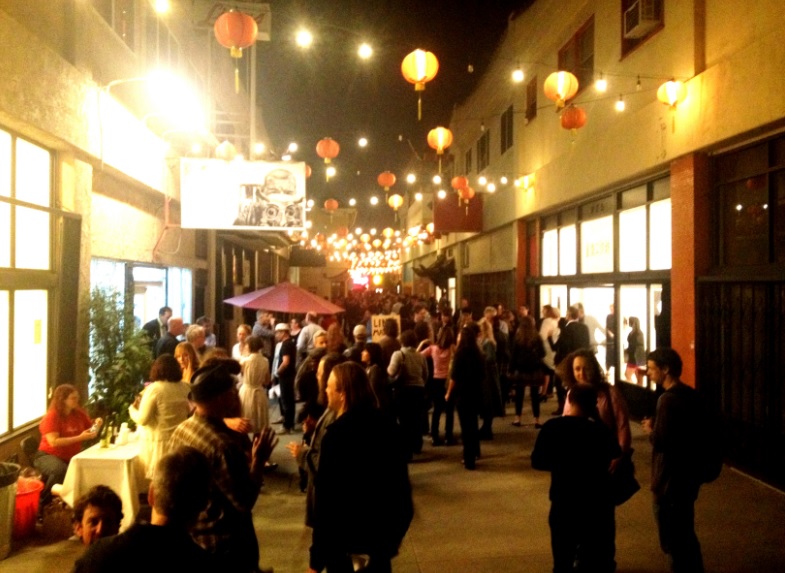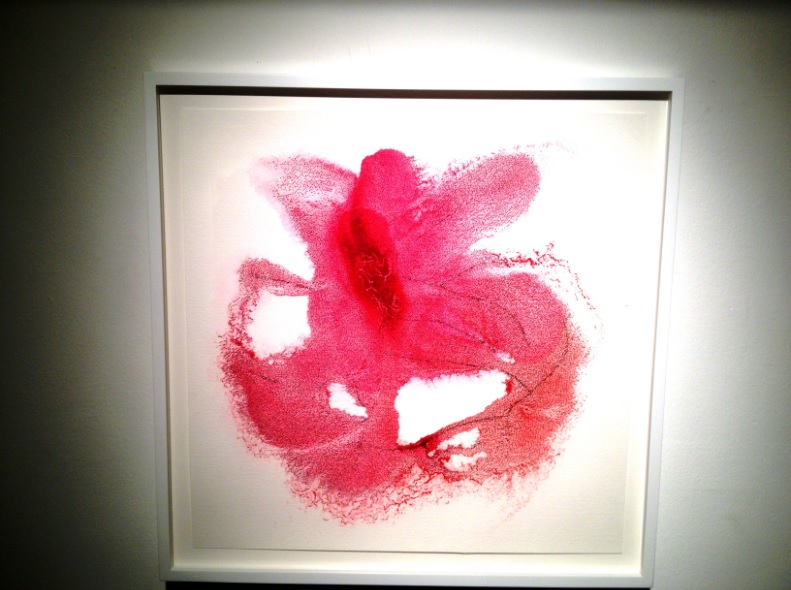Art Thrives Again On Chung King Road

Chung King Road, a pedestrian lane with 1930’s era two-story buildings has been home for many small, modern art galleries in recent years. Some gallery curators and tenants have remained, like Coagula’s Mat Gleason and Charlie James. James has had his gallery for the past eight years. But for the most part, modern art curators have treated Chinatown as a stepping stone, a temporary depot until a bigger and glitzier debut.
These days on Chung King Road however, the buzz feels like one of contentment.
What’s changed is that it’s 2014, and being downtown is cool. Also, far more people live downtown. The growth of trendy restaurants, shopping, bars and entertainment in downtown L.A. is at an all-time high. The critical mass currently visiting Chung King Road is unique because the art community that exists there doesn’t aspire to leave.
“This seems like the place to be, right?” mused Valerie Green, standing among her first solo exhibition at the Charlie James Gallery on Chung King Rd. Her larger than life images of iPhone screens were displayed on the main floor of the gallery, drawing wide-eyes from viewers who pushed in for an up close view of the collections entitled, “Look Up.” Downstairs, curator Katrina Umber assembled a group show entitled “Reds.” People mulled around chatting loudly, as metal buckets with canned beer sat sweating in the corner.
ALSO READ: Coachella 2014: Weekend One Recap
The individualistic vibe of the shows at Charlie James emanated from galleries up and down the lane. Earlier in the afternoon, Paige Wery, owner of newly opened The Good Luck Gallery, prepared for her first opening reception in the space.
Dressed in a summery, cotton dress, Paige sat perched in the window seat of the gallery next to a pack of American Spirits and her smart phone. She greeted afternoon visitors crossing the threshold of her horse-shoe emblazoned gallery with the enthusiasm of an art curator genuinely excited to talk about her assemblage.
Inside the bright, corner gallery, a sea of carefully placed ceramics expressed the personality and zeal of a man who has found himself an unexpected artist. At 103 years old, Harry Steinberg is not only one of the oldest sculptors in L.A., he may be one of the few born-and-bred Angelenos still alive and thriving at 103. It’s no small feat.
"Lean in so I can tell you how to take care of your new pet,” said Steinberg, congratulating a young man on his purchase of a ceramic dog. “Always have a bowl of water nearby, he doesn't get very hungry but he likes to be petted daily!"
During the evening opening of “103 Ceramics," The Good Luck Gallery was packed with guests, including a lively crowd of people 75 and older.
“It’s hot in there!” one woman exclaimed as she retreated to the outdoor bar. A couch rented for Steinberg and his wife sat unoccupied. During the three hour show, the jolly artist rarely sat down.
Trained as a surgeon, his passion for sculpting began as a hobby. Inspired by his wife, Claire Hanzakos, an artist, he began messing around with clay on weekends and in sculpting classes, which is where Wery stumbled upon him.

“Outsider art," work created by individuals with little or no structured training, is how Wery describes her preferred style of art. She began in Venice Beach, selling her own art and becoming entranced by the art created by local artists and homeless people making art on the boardwalk all day long.
Once a month she’d arrange a show at a coffee shop and display the artists’ work for the first time in their lives. Wery chose Chinatown for the gallery because of its affordability and charm.
Before settling on Chung King Road, Wery looked all over the city, and said she was turned off by the price of gallery enclaves like Culver City, where monthly rent can run $8,000-$10,000. She pays less than a quarter of that per month for a bright, open gallery space, small kitchen and an upstairs office.
Art curator Mario Vasquez has been following the ebb and flow of the art scene in Chinatown for several years. Vasquez argues Chinatown is a place where “experimental art has always been made." Case in point: if an artist can’t make the monthly payment in a Chinatown artist space, they’re not going to make it in more established (read: expensive) neighborhoods in L.A.
Chinatown is, for a gallery, Vasquez says, a place where an artist can test out their artwork and see if the project is going to sink or swim. Vasquez attributes the latest rise in artistic activity on Chung King Road as a positive consequence of several things including the economic rebound – artists and curators are ready to experiment again.
“People keep asking me who’s in my gallery program here, and I say, that’s the point - you’re not supposed to know them,” says Wery.
Art pieces from the show ranged in cost from $100 for small hand-painted tiles up to $1,200 for larger pieces – set at prices which curator Wery hoped would be affordable to Steinberg’s friends and supporters, as well as art collectors.
Since the opening, The Good Luck Gallery has sold several of Steinberg’s pieces. Buyers have included artists, art dealers, a real estate investor, a movie director, a rare book collector, professors and healthcare professionals according to Wery.
“Something that I’ve heard several times about Steinberg’s show is it makes people happy. That makes me happy,” Wery says.
Unique, uncompromised, truly authentic, these are general reactions overheard about the art debuting on Chung King Lane, as of late.
“There are restaurants, bars, you can park your car and spend a whole evening. All the galleries are doing their openings together - it’s great,” Wery says. Granted, she’s talking about Saturdays. This isn’t the Tuesday through Sunday schedule of Westside galleries. And by all appearances, the gallery curators on Chung King Road aren’t aiming for that.
“Chinatown’s still mom-and-pop, and that’s where you get the personal touch,” says Coagula Curatorial curator and art critic, Mat Gleason. “There’s no Gagosian Gallery," Gleason is happy to point out, referring to a gallery where modern art pieces can sell for multiple millions of dollars.
Gleason, 49, has been involved in the L.A. art scene for decades. In the late 90’s he was instrumental in founding the Arts District in downtown, a section of abandoned warehouses along the L.A. River which were converted to artist cooperatives and live/work studios. Today the Arts District is home to an Urth Caffe, the ultimate sign of decadent bohemian Hollywood living, and four star restaurants like Bestia. It’s become its own eastside yuppie art enclave.
Sitting upright on a faded white, pleather couch in Coagula, Gleason recalled the days when Nirvana played at the neighborhood bar. Today’s Arts District is a far cry from the steadfast art enclave that people like Gleason and Joel Bloom helped pioneer. Bloom ran a corner store which catered to artists and squatters in the neighborhood. It was one of very few operating stores in an otherwise abandoned neighborhood.
“The small room I rented for $324 in 1994 with a bathroom down the hall is now $1,000 with a waiting list to get in,” says Gleason disapprovingly. “I had a conversation with Joel in the mid 90’s. I said, once you call this an Arts District, people who aren’t artists are going to want to live here.”
“Life-stylers," Gleason calls them.
What happened to the Arts District will never happen to Chinatown, he argues, if for no other reason than Chinatown’s unique and irreplaceable cultural fabric. Gleason says he recently renewed Coagula’s lease for another five years. During afternoons and weekdays, the lane is peacefully deserted. Most galleries are open only on the weekends. The Good Lucky Gallery and Coagula are open Wednesday through Saturdays. But Saturday evenings are when things light up.
Food trucks, a staple of hipster lifestyle and art culture, aren’t welcome. At least not yet. If galleries want to serve food at openings, it’s implied that the galleries show respect for the scores of Chinese restaurants and order food from them.
Accordingly, The Good Luck Gallery’s opening reception opted out of cheese and crackers, featuring egg rolls from a local restaurant instead.
Detractors speculate whether modern art and its fans dilute the Chinese character of Chinatown. But Gleason argues there never was a pure, more authentically Chinese past. Chinatown, with its stylized architecture, was designed to lure outsiders. And Gleason cautions against distorting the past. As a kid growing up in L.A, he recalls his parents’ generation adopting an anti-Chinese attitude and refusing to buy things “Made in China” in an anti-Communist stance.
“If you want to be all nostalgic and long for a world that no longer exists, I don’t know what to say.” He asserts that the blend of old and new in present-day Chinatown is amicable and mutually beneficial for both modern businesses and old-school residents.
Reach Arts and Culture Editor Ashley Riegle by email. Follow her on Twitter here.



